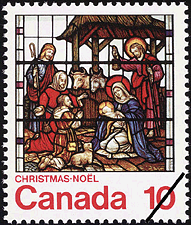Nativity - 10 cents 1976 - Canadian stamp
Specifications
- Quantity: 84 100 000
- Issue date: November 3, 1976
- Printer: Ashton-Potter Limited
- Scott: #698
Description
From melted sand, the humblest of materials, comes the beauty of stained glass. The window depicted in this stamp issue adorns the wall of a Canadian church. Stained glass probably had its origin in the Middle East, the birthplace of glass manufacturing. The technique developed slowly because glass equalled diamonds in value and perhaps because this new art, with its sharp glass fragments and molten sand, was dangerous to work at. The main ingredient of glass is sand, which melts at temperatures above 1700°C, although a catalyst reduces the melting point to 850°C. Lime can be added to the mixture to make a harder glass. Other chemicals will colour it. In medieval times, when the design was ready and the coloured glass had been cut, it was painted with details. The craftsmen next cooked the paint into the pieces of glass and fixed them in long, H-shaped strips of lead. Once cement or putty was rubbed into the cracks between lead and glass, the window could be hung. These techniques have changed so little since then that a medieval glazier could easily go to work in a modern shop. A knowledge of Christianity is essential for even a cursory study of stained glass, since it has been largely a western and a Christian art. Christmas has naturally been a popular topic, and an enduring symbolism has arisen to represent, in glass, the joy, the love, the giving and the wonderment which characterize the season. The figures of the Holy Family, the worshipping shepherds, and the animals of the stable have often been portrayed in stained glass and they convey the same message to contemporary humans as they did to medieval peasants. Thus, stained glass, perhaps better than any other art form, exemplifies the never ceasing power of Christmas to inspire. Despite rampant commercialism and materialism, which rise to new heights each year as December 25 approaches, Christmas still retains its amazing ability to uplift the spirit and to stir the conscience. People can still look forward to Christmas as a period of spiritual renewal after the problems of the preceding months. Canada is probably one of the most interesting places in the world to observe Christmas. Our long history and the richness and variety of our cultural traditions are responsible for this. Most of our ethnic groups have distinctive Christmas customs, songs, religious festivities, decorations and food. All these things help impart a sense of tolerance and fellowship, adding to, rather than detracting from, the great reverence with which people celebrate Christmas in each area of the nation. The 1976 Christmas stamp feature Canadian stained glass windows of Nativity scenes. The 10¢ stamp depicts a window in the church of St. Jude, London, Ontario, which was produced in 1964 by G. Maile & Son of London, England.
Canada. Post Office Department. [Postage Stamp Press Release], 1976.
Creators
Based on a stained glass window by G. Maile & Son Limited
Designed by Bernard N.J. Reilander
Original art
G. Maile & Son Limited, "Nativity", 1964
Church of St. Jude, London, Ontario
Right now on Ebay (Ad)
Stampsandcanada.com is supported by its audience. When you buy through links on our site, we may earn a commission.
See more »Note
The values on this page are in Canadian dollars (CAD).

